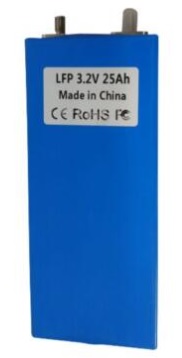
What Are The Safest Lithium Battery Cells?
Table of Contents
If you are wondering what the safest lithium battery chemistry as of today LTO formally known as Lithium Titanate Oxide takes the safety crown. This chemistry is the safest due to its extremely stable chemical compositions and tolerance to harsh conditions.
In second place is LFP (Lithium Iron Phosphate), which is safer than NMC (Nickel Manganese Cobalt Oxide) cells because it has a more stable structure and reduced overheating risks. Learn about the detailed comparison of LFP and NMC from our other articles.
What Are The Safest Cells By Chemistry?
Compared to all other lithium ion cell chemistries, LTO (Lithium Titanate Oxide) cells are by far the safest type available.
LTO cells stand unrivaled in their resilience to potential hazards, demonstrating remarkable resistance to combustion even under severe conditions. For example, an LTO cell won’t catch fire even if it is subjected to extreme physical stresses like being pierced with a knife or struck with a hammer. While it may heat up slightly and release some liquid — which could be either clear or black — the temperature rise isn't significant enough to ignite nearby materials or pose a substantial fire risk.
In contrast, if an NMC cell is pierced with a knife it’s going to instantly get super hot and start emitting tons of gasses, heat, and smoke. Before you know it, things will be on fire.
This superior safety profile is attributed to the robust design and unique chemistry of LTO batteries. They are engineered to resist thermal events effectively, dramatically minimizing the likelihood of fires or explosions. This resistance holds true even in scenarios of extreme physical damage or even overcharging, which are common threats to the safety of many other lithium-ion batteries.
However, it's important to emphasize that safety doesn't solely depend on the type of battery. Whether you're using an LTO, LFP, or NMC cell, adherence to proper handling, using a correct battery charger, and battery storage practices play a pivotal role in ensuring safety. Improper usage or negligence can pose risks even with the safest batteries.
Is LTO Safer Than LiFePO4?
Yes, LTO is safer than LiFePO4. When it comes to safety in the realm of lithium-ion batteries, LTO (Lithium Titanate Oxide) offers an absolutely remarkable resistance to overcharging, short-circuiting, and mechanical damage. These features make LTO batteries one of the safest lithium-ion batteries on the market.
So, what are the risks of LiFePO4 batteries? LFP (Lithium Iron Phosphate) batteries can't quite match up to the robustness of LTO. It’s true that LFP cells are much safer than most other types of lithium batteries, but if they are subjected to mechanical damage, overcharging, or excessive current flow, theft tend to heat up, potentially releasing some liquid and gasses. Although it doesn't usually produce shooting flames like some other battery chemistries, it can still pose a fire hazard.
Due to LFP mostly safe nature and higher capacity than cells using the LTO chemistry. LFP is used as a good middle ground between safety and capacity. You often see LFP cells used in battery storage or in car audio in the case of the 38120 Headway cell.
Consequently, LTO batteries offer an edge in terms of safety compared to LFP. The inherent stability of LTO significantly reduces the risks of fire incidents, thus elevating the level of safety when employing these batteries in various applications.
Is LTO Safer Than NMC?
Yes, LTO is definitely safer than NMC. When comparing LTO batteries with NMC (Nickel Manganese Cobalt) chemistry, it's clear that NMC is the much more dangerous option. NMC, a chemistry frequently utilized in LiPo (Lithium Polymer) batteries and 18650 battery cells, is extremely volatile. Because of this, if the internal components of NMC cells come into contact with each other, it will more than likely lead to a substantial thermal event, which can cause a fire or even an explosion.
Canister NMC cells, protected within a durable steel casing, provide an extremely high degree of protection against physical damage. This safety, however, is compromised if substantial force is applied to these cells. Meanwhile, LiPo batteries, which possess the same sensitive chemistry as NMC, are even more vulnerable due to their soft outer cover and plastic electrolyte. This soft outer casing is one of the main disadvantages of LiPo pouch cells.
In comparison, LTO batteries can withstand prolonged overcharging or excessive current flow without the same level of risk as NMC and LiPo cells. Due to LTOs extreme ability to handle abuse and output current it is commonly used for car audio battery banks. This resistance to common safety threats solidifies LTO's position as a safer, more stable option among lithium-ion batteries.
Comparing LTO to NMC and LFP in terms of safety
Not all lithium batteries are equally safe. The safety of lithium-ion batteries is primarily determined by their chemical composition and thermal stability. While they are all based on lithium, the other chemicals required for each cell type have their own complex interactions.
LTO (Lithium Titanate) batteries are carbon-free, significantly reducing the risk of thermal runaway or overheating. Their high tolerance to wide temperature ranges also contributes to their safe operation across various applications. They offer poor energy density, so it requires a lot of large cells to form a battery pack.
LFP (Lithium Iron Phosphate) batteries deliver a balance between energy density and safety. They have a stable chemical structure that reduces overheating and tolerance to overcharging, eliminating cobalt, a material linked with safety and ethical concerns. These are much more energy-dense than LTO cells but are a little more dangerous to use.
NMC (Lithium Nickel Manganese Cobalt Oxide) batteries, both canister and lipo forms, offer high energy density but possess a higher risk of thermal runaway due to the presence of nickel, which can catalyze oxidation reactions. These cells provide the absolute most energy density, so they are required for compact, high capacity, high current battery packs.





